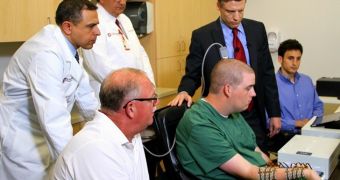Scientists are pleased to announce that, with the help of a so-called neural bypass system dubbed Neurobridge, a 23-year-old man has managed to use thoughts alone to move his hand.
The researchers who worked on developing and testing this system explain that Neurobridge made it possible for the quadriplegic man to move his hand by rerouting signals originating in the brain.
Thus, the signals intended to cause contractions in the 23-year-old's hand muscles did not travel along the natural route, i.e. from the brain, via the spinal cord, and on to his muscles, Live Science informs.
On the contrary, the signals formed in the brain, were picked up by the neural bypass system, and were sent directly to the muscles in the man's hand. Simply put, the damaged spinal cord was left out, the same source explains.
Information shared with the public says that Neurobridge comprises a computer chip, a brain-computer interface, and a high-tech sleeve that feeds the signals into the targeted muscles.
In order to make sure that the neural bypass system will in fact help Ian Burkhart move his hand, the researchers and doctors who handled this case had to perform brain surgery on the 23-year-old man.
This is because, in order for it to do its job and pick up the correct signals, the chip had to be implanted in the brain, and not just anywhere, but in the motor cortex region in charge of controlling arm and hand movement.
To identify this region, specialists relied on an fMRI machine that helped them pin down activity patterns and signal routes in the brain. Once they figured out where to place the chip, it took them about three hours to get the job done.
Commenting on how the chip works when sorting through various brain signals and choosing only the correct ones, researcher Chad Bouton said, “It's like walking into a crowded room with hundreds of conversations going on, isolating just one and learning the language being spoken.”
Interestingly enough, the signals that left his brain when Ian Burkhart moved his hand were not exactly the same as the ones that reached his muscles. Thus, after being fed in a computer, the original signals were recoded so that the sleeve and the muscles could make head and tail of them.
The scientists behind Neurobridge say that they wish to test their neural bypass system on several other patients in the months to come. They hope that, at some point in the not so distant future, this technology will serve to treat various forms of paralysis.

 14 DAY TRIAL //
14 DAY TRIAL //